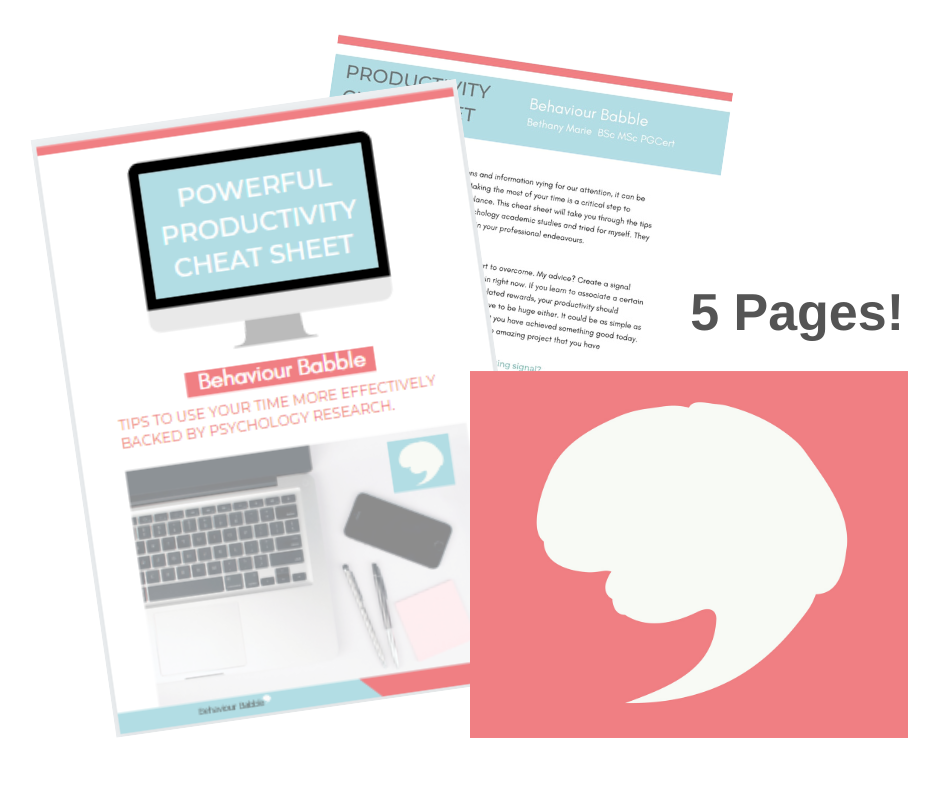One of the most popular self-help techniques available is self-monitoring, whereby the act of tracking your behaviour is enough in itself to bring about significant positive changes to your habits (Fredrickson & Losada (2005). See my blog post for more information here. Food diaries and Fitbit are two great examples.
But when your motivation starts to drain away, and that chocolate bar starts to look more appealing, keeping tabs on your progress can quickly go out the window. Fitness apps get deleted and food diaries lie hidden in draws. If that sounds familiar to you, then you might need a little extra incentive to change your behaviour for the better!
Although self-monitoring is a useful tool in turning bad habits around, it is only the tip of the iceberg. A plethora of simple and effective behaviour change tactics awaits!
The methods that I will discuss here all come under the same umbrella category; they aim to alter your habit by first changing the consequences of your behaviour.
The term “consequence” often conjures up negative connotations. Images of children being stopped by their parents with the phrase “There will be consequences for your actions young man!” spring to mind. But in this article, I want to encourage you to view consequences as a more broad sense. All of our actions incur some kind of consequence, both good and bad, immediate or delayed.
When you define consequences using the scientific lingo, they can be described as “A stimulus change that follows a behaviour of interest” (Cooper, Heron, & Heward, 2007). Said in plainer English, a consequence is something which occurs after your behaviour and affects the likelihood of you acting in the same way again in the future.
Your mum gave you ice cream after eating your veggies. Your partner complained when you left the dishes in the sink. You receive a pat on the shoulder for a job done well.
All of these examples include a behaviour first and a consequence second.
The chances are that if your ‘bad habit’ is a stubborn one, then it is being reinforced and maintained by a certain consequence. To find out exactly why it is occurring, read my other article here.
So how do you use this information about consequences to change your unwanted habits?
Changing the Consequences: Two Options to Try
(First of all, it can be helpful to define your goals and the specific behaviour that you want to change).
There are two main categories of consequences, ones that reinforce or encourage a behaviour to occur again or ones that punish and make a behaviour less likely to reoccur. In self-help terms, you can choose to either reinforce the behaviours that you are striving for (i.e eating more fruit) or punish the behaviours that you want to diminish (i.e. eating fast-food). Let’s take a look at both options individually.
Reinforcement
Do you want to see more of the behaviour you are measuring?
Such as; to smoke fewer cigarettes, eat less junk food, exercise more, write more pages of work, eat more portions of fruit n veg or doing the housework.
If yes, then you can follow one of these principles….
- If you meet your goal then give yourself a small reward. Something that you enjoy. (This is positive reinforcement). A few examples of these include; receiving a compliment, cold hard cash or time to spend on social media.
- You will continue to do your ‘good habit behaviours’ because you want to avoid or escape from doing something that you dislike. You will set up the contingency that if you do not meet your goals, then you will have to do something which you do not want to do. (Negative reinforcement). Some examples include; doing your housemates chores, performing 10 sit ups and paying £3 into your partner’s computer games fund.
When using this tactic, you need to create a link between doing the behaviour that you want to engage in and either getting something nice or avoiding something you don’t like. An effective reinforcing consequence will increase the frequency of your behaviour over time. Reinforcement can keep you on the path to sticking with healthier habits!
Punishment (But not as you know it!)
Do you want to see less of the behaviour that you are measuring?
For example; smoking, drinking beer, eating unhealthy food or procrastinating.
If yes, then you can follow one of these principles:
- Every time you catch yourself doing what you shouldn’t be doing, you must experience something that you dislike. For example, if you tend to bite your nails, apply a foul tasting polish so that you will experience a bad taste if you continue nail-biting. (Positive punishment)
- When you do what you shouldn’t be doing, you agree to lose something which you like or to remove yourself from an enjoyable activity for certain amount of time (more famously labelled as time out). (Negative Punishment).
Through this method, you are aiming to create an association between doing your bad habit and either getting something you don’t want or losing something that you like. An effective punishing consequence will reduce the frequency of your unwanted behaviour. Punishment helps to stop you from doing what you know you shouldn’t be doing
Which Strategy Should I Use?
Personally, I would recommend sticking with reinforcement strategies because they are more nurturing and encouraging. They allow you to focus on the actions that you want to see more of, rather than stopping the “bad” behaviours you are doing too often. Punishment strategies do have their merit and they have been used successfully within apps to promote healthy eating. But you should also be careful when applying them to avoid any untoward side effects (Bailey & Burch, 2006).
Do you have any habits that you would like to change? Which consequence strategy would you use to help you to reach your behaviour change goals? Let me know in the comments section below.
Be sure to keep reading Behaviour Babble! I will have some handy troubleshooting tips coming soon, to help you to use these consequence with maximum success!
References
Note: If you are interested in a much more technical and thorough explanation of consequences, then be sure to read Cooper, Heron and Heward’s book Applied Behavior Analysis (2007). I credit this text which I used to form the definitions of consequences that I wrote about in this blog post. A perhaps more user-friendly book to look up is “How to think like a behavior analyst” by Bailey and Burch (2006).
Bailey J, Burch M (2006). How to think like a behavior analyst: Understanding the science that can change your life. Mahwah, NJ: Erlbaum.
Cooper, J.O., Heron, T.E., & Heward, W.L. (2007). Applied Behavior Analysis (2nd ed.). Upper Saddle River: NJ.
Fredrickson, B. L., & Losada, M. F. (2005). Positive affect and the complex dynamics of human flourishing. American psychologist, 60(7), 678.
Image via Pexels
Beth is forever curious about what makes people tick. She is a master’s degree graduate and former psychology teacher (AKA a proud behaviour nerd!). Autism awareness is a cause close to her heart – check out her fundraiser. Beth becomes her happiest self when she’s helping people like you to enhance your life.
Join our community. Get ahead. Make the most of your time with our free guide!




